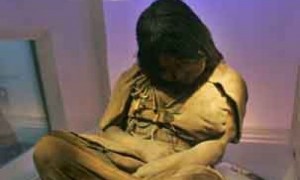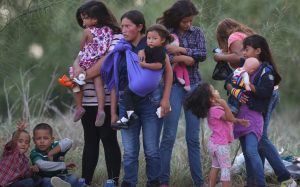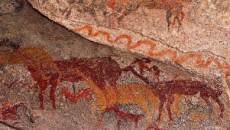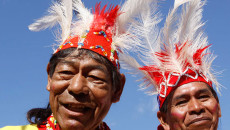By Ivonne Jeannot Laens
Global Press Institute
Some years ago, a group of archaeologists found the frozen corpses of three indigenous children atop a volcano, which they determined had been Inca sacrifices. Today, the perfectly conserved corpses are on exhibition at a museum in northwestern Argentina, where thousands of people come to see them every month. But the exhibition has caused controversy, as local indigenous communities demand the return of the bodies, scientists worry about their preservation in the museum and others question the humanity of the display.

SALTA, ARGENTINA – Three children, ages 6, 7 and 15, left their towns one day and set off toward the peak of a volcano. Accompanied by Inca priests, they walked for months or even years until they at last reached the Llullaillaco Volcano in northwestern Argentina. There, the priests got them drunk and buried them alive as an offering to the gods.
The Incas selected the two girls and one boy for their beauty and perfection. The girls wore tunics, fitted at the waist, and long braids in their hair. The boy donned a large headdress made of white feathers. The priests buried them with various objects that symbolized life in the communities: miniature gold statues, vessels, sandals and small bags of dried food.
This all occurred some 500 years ago, during the time of the Inca Empire. After uncovering the children’s bodies at 6,700 meters above sea level in 1999, the expedition group carefully reconstructed the details of the long walk and the objective of the sacrifice.
Archaeologist Christian Vitry says he was one of the 14 men and women who participated in the expedition, led by Johan Reinhard, a U.S. explorer for National Geographic Society and the principle investigator for The Mountain Institute. After studying Inca culture for years, Reinhard had strong suspicions that they would find human remains atop the volcano.
Vitry says that he and his fellow expedition members had to withstand difficult climactic conditions to reach their destination, with temperatures plummeting down to 40 degrees Celsius below zero and strong gusts of wind.
“When we established the final camp, at a height of 6,600 meters, a storm broke,” he says. “It lasted four days, and the tents were covered in snow.”
But at the peak, they were able to uncover the first body, a 7-year-old boy in a gray tunic, according to local media reports covering the expedition’s discovery. He was frozen in the fetal position with a brown and red blanket covering his torso. The researchers named him, “El Niño,” or, “The Boy.”
Soon they found a 15-year-old girl, whom they baptized, “La Doncella,” which means, “The Maiden.” Her legs were bent and crossed, and her hands rested on her abdomen. A cloak covered her back, and a metal adornment hung from her chest.
Finally, they uncovered the body of a 6-year-old girl. Her head was upright, allowing the expedition members a perfect view of her face, which was framed by her black hair. Part of her head and her chest had been burned by a lightning bolt, so they named her, “La Niña del Rayo” – “The Lightning Bolt Girl.”
Vitry says the Incas sacrificed the children following a ritual characteristic of the period called “Capacocha.” During this ceremony, the children first visited the center of the Inca Empire, which was located in Cusco, Peru, and then walked to the places where they would be sacrificed. The sacrifice’s objective was to show appreciation to the gods for water and the other vital elements and to ask them for protection.
The archaeologist says that the Incas had a different concept of life and death.
“They believed that the children didn’t die but slept and later woke up together with their ancestors and deities,” he says.
La Universidad Católica de Salta initially safeguarded the bodies. The provincial government later decided to erect the Museo de Arqueología de Alta Montaña in order to exhibit the mummies, known as Los Niños del Llullaillaco. Vitry is today the official archaeologist of the museum.
Los Niños del Llullaillaco have been exhibited in the museum since 2007, but they still generate strong controversy today. As descendants of the Incas, local indigenous communities demand the museum return the children’s bodies to them so that they can honor them according to their traditions. Another issue is the humanity of the public exposition of corpses, which attracts some visitors and repulses others. Finally, from the scientific side, there is a fear that exposure to artificial light in the exhibit will affect the preservation of the bodies.
The Inca Empire reigned from 1200 to 1532, eventually spanning an extensive territory from the south of present-day Colombia down to the Argentine province of Mendoza. The Incas conquered numerous communities that inhabited these regions, before being conquered themselves by the Spanish. From the fall of the empire, the Spanish dominated these communities throughout the region, using them for heavy labor and forcing them to abandon their beliefs and customs.
The Argentine government reversed this in 2000 with the ratification of the International Labour Organization Convention No. 169, which recognizes the right of indigenous peoples to have a different and lasting existence. Anthropologist Marta Flores says that this began a long process of reaffirming indigenous identities, such as that of the Kolla, an indigenous community in the region.
“Before, to call someone ‘Kolla’ was a very strong insult,” she says. “Today, the Kollas recognize themselves as such with pride. The different communities share the opposition to the alienation from their lands. The exhibition of the children is another alienation that they suffer, and, for this, they demand that they are returned.”
Many other communities indigenous to the region unite around this demand, such as the Diaguitas-Calchaquíes, the Wichís and the Lules. Fermín Tolaba, chief of the Lules, says he is against the exhumation of the children’s bodies.
“The bodies should have stayed in their territory,” he says. “Now that they are already exhumed, they would have to return them. It is not good that the museum is earning money with that, charging an admission for something that doesn’t belong to it.”
The admission to the museum is about 40 pesos ($10).
Vitry, the museum archaeologist, says that the museum staff always tried to include the indigenous communities in the preparation of the exhibit.
“Before the bodies were exhibited in the museum, the different communities were invited to celebrate their rituals here,” he says. “We have always worked in contact with the indigenous communities.”
On the occasion of the Primer Foro Internacional de Educación Intercultural Bilingüe de Enseñanza Indígena, which took place in 2005 in Salta, representatives from the different indigenous communities issued a document on the matter. It explained that the Llullaillaco Volcano was a sacred mountain that shelters, maintains and protects the bodies of their ancestors, which are maintaining a vital energetic balance.
“But logically, this knowledge and ancestral science is far from being grasped and understood by Western scientists, who only consider our sacred heritages as mere objects of study and exhibition,” the document states. “We condemn and denounce before world public opinion the so-called exhibition of those children, human beings with the right to rest in peace and to respect for their privacy.”
The signers demanded the immediate restitution of the bodies to the sacred place where they had been exhumed. The document triggered numerous meetings between indigenous representatives and provincial authorities. There were also many indigenous protests in front of the museum in the years leading up to the exhibition.
Anthropologist Mabel Mamani, who worked as a guide at the museum for many years, says that those meetings clearly showed the different positions within the indigenous communities.
“There were those who were worried because their animals were dying and they needed money,” she says. “Others simply demanded that the bodies were returned.”
The demands dissolved, and the restitution never happened. Various sources, who requested anonymity, indicated that the indigenous communities don’t feel well-represented by their leaders. Some feel that these indigenous delegates only came to office to achieve personal benefits from working with provincial authorities.
One of the protest leaders from the beginning was Miguel Siares, chief of the Comunidad Indígenas Kollas Unidos. Once detained during the protests, he now has a fluid dialogue with the museum and supports the exhibition of Los Niños del Llullaillaco.
“I was never in agreement with the desecration of the children,” he says. “But in spite of everything, we have been searching for a coordination with the authorities. We have achieved harmony for the children, evading a confrontation. Here they are well cared for. We only demand that this does not happen again, that if they discover new bodies that they stay in the mountain.”
Beyond the controversy with the indigenous groups, the exhibition of corpses generates conflicting opinions in the public. Flores says she rejects the morbid fascination it can generate in some visitors.
“I condemn the form in which they are being exhibited because it doesn’t have anything to do with the memory, with the preservation of a history,” she says, “but rather that they try to show it because it sells, because it attracts, because it makes an impression.”
Vitry agrees it can be evocative.
“There are people who leave the museum crying,” he says.
Adrián Sastre, a storekeeper in Salta in his 40s, says the exhibition bothers him.
“They are children,” he says. “They shouldn’t be here in showcases.”
On the other hand, some visitors leaving the museum say it wouldn’t be the same to see only a reproduction of the bodies.
“The children shock you because they are small,” says Mariela Nacimiento, a woman in her 30s. “But it’s good that they are exhibited. It wouldn’t be the same if they were replicas.”
A man in his 50s visiting from Buenos Aires agrees.
“The tourism guide told us about the children, and I came to the museum especially to see them,” he says. “It wouldn’t have aroused as much interest if they were reproductions.”
From the scientific side, the controversy revolves around preservation.
“In the area of cryopreservation of the museum, doubts persist in regards to the effects the light can have on the bodies,” Vitry says, referring to the process in which cells or tissues are preserved through cooling. “Under current conditions, we are supposedly guaranteed the preservation of the bodies for 200 years.”
He says that in order to reproduce the exact conditions in which they found the corpses on top of the volcano, they undertook new expeditions in order to measure the climactic conditions during different times of the year. In this way, they could precisely adjust the temperature and humidity. But the bodies weren’t exposed to light on top of the volcano as they are in the museum.
Vitry says that in order to avoid deterioration, the museum specialists ordered the bodies to be exhibited one at a time while the others remain in the dark of the laboratory. They also placed light filters in the showcases in which the bodies are displayed in order to protect them. Digital colorimeters in the bodies detect changes in their coloration, another indicator of possible decomposition.
“When a body decomposes, there is a process of hydration or of dehydration, and that reflects in the weight,” Vitry says. “For this reason, the bodies of the children rest in digital balances. Any change sounds an immediate alarm.”
In terms of any morbid fascination the exhibition could cause, Vitry says that they sought to emphasize the context and the Inca culture, always toning down any language relating to human sacrifice.
A new idea is to install a wall in the museum in front of where the children are exhibited.
“Facing a future remodeling is a possibility,” he says. “The idea is that on that wall, the visitor is warned that he or she is about to see the bodies and can decide to leave the exhibition before reaching them.”
The specialist says that amidst all the controversy, the exhibition always prioritizes respect.
“Everything we did in the museum was done in a mark of respect,” he says. “It is a complex matter. For me, the objective is to transform the initial attraction, perhaps morbid, of seeing a body exhibited into a tool to educate about pre-Hispanic ancestors.”
Flores says that the debate is still not settled. On the contrary, she says it will continue to create a clash between two cultures.
“Los Niños de Llullaillaco exemplify the clash between the scientific ideology and an indigenous view of the world of what is life and death and of the place that that occupies in the mind of the people,” she says. “What happens is that the scientific always has the support of the authorities.”
The story was originally published by Global Press Institute. (c) Global Press Institute 2012




